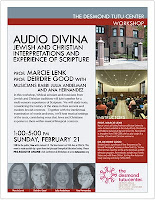Everyone knows that musical settings of Psalms and Canticles affects their meaning. Our musicians sang the same Psalm in different settings to let us hear this. For example, here's a well-known setting of Psalm 23 by Howard Goodall, used as the theme tune for "The Vicar of Dibley." What does this setting convey to you? Classic FM (a UK Radio station) has put it onto their CD "Relaxing Classics" which tells you how they view it. Also well-known is the setting of Psalm 23 by Crimond, often played at funerals.
We do not own the Bible. So what do Christians know about use of Psalms in other religious settings? We learnt that in Jewish tradition, Psalm 23 is associated with the Sabbath. When we hear Psalm 23 sung this way (scroll down to Psalm 23) we hear sadness. This slow melancholic setting composed by Ben Zion Shenker conveys a notion that the Sabbath will soon end and perhaps also a longing for its return.
We listened to a fascinating exposition of Hannah's Prayer and looked at the connections between Hannah's Prayer and the Magnificat:
| Hannah’s Song – 1 Samuel 2:1-10 Hannah prayed and said, “My heart exults in the Lord; my strength is exalted in my God. My mouth derides my enemies, because I rejoice in my victory. There is no Holy One like the Lord, no one besides you; there is no Rock like our God. Talk no more so very proudly, let not arrogance come from your mouth; for the Lord is a God of knowledge, and by him actions are weighed. The bows of the mighty are broken, but the feeble gird on strength. Those who were full have hired themselves out for bread, but those who were hungry are fat with spoil. The barren has borne seven, but she who has many children is forlorn. The Lord kills and brings to life; he brings down to Sheol and raises up. The Lord makes poor and makes rich; he brings low, he also exalts. He raises up the poor from the dust; he lifts the needy from the ash heap, to make them sit with princes and inherit a seat of honor. For the pillars of the earth are the Lord’s, and on them he has set the world. He will guard the feet of his faithful ones, but the wicked shall be cut off in darkness; for not by might does one prevail. The Lord! His adversaries shall be shattered; the Most High will thunder in heaven. The Lord will judge the ends of the earth; he will give strength to his king, and exalt the power of his anointed. | Mary’s song (Magnificat) – Luke 1:46-55 And Mary said, “My soul magnifies the Lord, and my spirit rejoices in God my Savior, for he has looked with favor on the lowliness of his servant. Surely, from now on all generations will call me blessed; for the Mighty One has done great things for me, and holy is his name. His mercy is for those who fear him from generation to generation. He has shown strength with his arm; he has scattered the proud in the thoughts of their hearts. He has brought down the powerful from their thrones, and lifted up the lowly; he has filled the hungry with good things, and sent the rich away empty. He has helped his servant Israel, in remembrance of his mercy, according to the promise he made to our ancestors, to Abraham and to his descendants forever.” |
Mary's song voices her own praise and that of Elizabeth and Hannah. We considered the prominent use of the verbs in both songs since personal pronouns are given undue emphasis in English translations. Exalting and magnifying and praising in the opening lines connect to the celebration of God's exaltation and raising of the poor in the rest of the song. And each conveys the promise of the future. Then one of our musicians sang an improvised setting of the Magnificat emphasizing the verbs.
We were challenged by Psalm 137 and the paradox of singing a song that cannot be sung and we discussed theological implications of including all verses. We pondered the absence of lament in our Episcopal liturgies and funeral services. At the end of the workshop we celebrated the praise of Psalm 150. We left with a deeper sense of new and shared understandings of our common textual and liturgical traditions as a sound basis for respect and collaboration in worship and other settings. I am very grateful to the Evangelical Education Society of the Episcopal Church for making the workshop possible.



